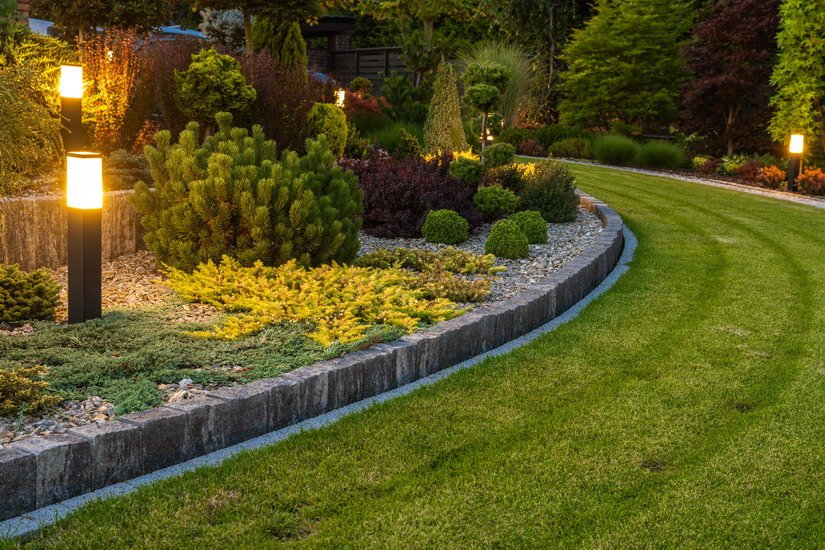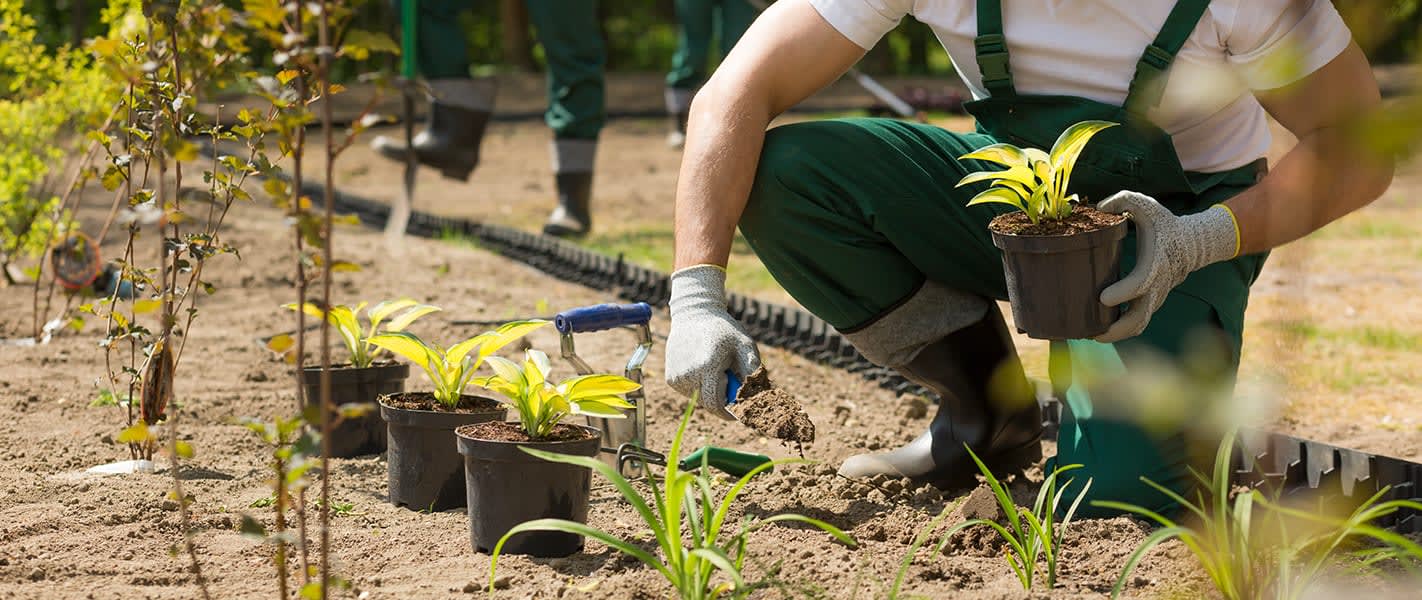An expert’s checklist for choosing the right landscaping services
Wiki Article
Recognizing the Comprehensive Range of Works in Professional Landscape Design Services
The substantial range of professional landscaping services incorporates a selection of fundamental components - landscaping. It consists of landscape design principles, plant selection, and hardscaping attributes. Additionally, it resolves watering systems and upkeep techniques. Each facet plays an essential role in developing useful and cosmetically pleasing outside spaces. Recognizing just how these components interact can disclose much concerning the art and science of landscape design. However, the journey right into this intricate field is just beginningLandscape Style Concepts
Reliable landscape design principles are crucial for developing unified exterior rooms that enhance both aesthetic allure and performance (Learn More). These concepts assist the arrangement of aspects within the landscape, ensuring a cohesive visual experience. Secret elements consist of balance, which disperses aesthetic weight evenly; proportion, which associates the size of different aspects per various other and the space; and unity, which creates a sense of wholeness via consistent motifs and materials
Plant Choice and Setup
In the domain of professional landscape design, plant choice and setup play an important function in achieving a growing yard. Stressing indigenous plant advantages, seasonal considerations, and the specific dirt and sunlight needs of each species guarantees a sustainable and aesthetically pleasing landscape. Careful preparation in these areas not only boosts biodiversity but likewise advertises lasting eco-friendly health and wellness.Native Plant Benefits
Why should house owners consider indigenous plants for their landscape design tasks? Native plants supply many advantages that enhance both visual appeals and ecological sustainability. They are well-adapted to local environments, needing much less water and maintenance compared to non-native varieties. This durability reduces the requirement for chemical fertilizers and chemicals, promoting a healthier ecological community. Furthermore, native plants supply environment and food for local wildlife, including pollinators, which can increase biodiversity in property locations. Their familiarity with regional dirt and climate conditions also leads to much better development prices and long life. By picking native plants, property owners not only develop visually enticing landscapes however additionally add to ecological conservation, making a positive influence on their neighborhood setting. Native plants represent a smart choice for landscaping projects.Seasonal Plant Considerations
House owners that have actually embraced indigenous plants in their landscaping can further enhance their outdoor rooms by taking into consideration seasonal plant selections. By integrating plants that grow in particular periods, they can create visually appealing and dynamic landscapes throughout the year. Springtime may usher in lively blooms like tulips and daffodils, while summertime can showcase lush foliage and vivid perennials. Autumn presents a scheme of cozy tones with goldenrods and asters, while winter season can be emphasized with evergreens and ornamental grasses for appearance. Specialist landscapers usually advise picking plants that not only complement existing indigenous species yet also give year-round passion and assistance local wild animals. This thoughtful method to seasonal plant choice ensures a continuously advancing and lasting yard setting.Soil and Sunshine Demands
Effective landscape design rests on comprehending the specific dirt and sunshine needs of plants. Various types prosper under varying problems, requiring a mindful evaluation of both elements during the choice process. Soil types, such as sandy, clay, or fertile, impact drainage, nutrient availability, and origin advancement. Furthermore, pH levels can affect plant wellness, demanding dirt testing to establish viability. Sunshine requirements vary significantly; some plants grow completely sunlight, while others like partial or full shade. An expert landscaper considers these elements to ensure peak development and visual charm. By lining up plant selections with the environment's specific attributes, landscapes can attain sustainability, resilience, and visual harmony, eventually resulting in effective plant facility and long-term maintenance.Hardscaping Attributes and Construction

While landscaping often evokes pictures of lavish plant and lively flowers, hardscaping features play a crucial role in specifying outside rooms. These elements, which consist of outdoor patios, sidewalks, preserving walls, and attractive stonework, supply structure and performance to backyards and yards. Hardscaping makes use of materials such as concrete, brick, timber, and stone, allowing for diverse designs that enhance the natural landscape.
The building and construction of hardscaping attributes calls for cautious preparation and implementation to ensure durability and visual allure. Experts analyze site problems, water drainage, and spatial connections to produce natural outside atmospheres. Correct installation techniques are vital, as they protect against concerns like disintegration and moving over time.
Incorporating hardscaping not just enhances the visual passion of a building however also promotes outside tasks, making it a basic facet of extensive landscape design services. Eventually, thoughtful hardscaping adds to both the performance and appeal of outside areas.
Irrigation Equipments and Water Monitoring
Reliable watering systems and water monitoring are crucial parts of specialist landscaping, as they guarantee that plants get the required hydration for excellent growth. These systems can differ from easy drip watering configurations to sophisticated automatic automatic sprinkler, designed to satisfy the specific demands of diverse landscapes. Correct water monitoring not just maximizes water usage, lowering waste, yet also improves plant health and reduces disease threats.Landscape design experts evaluate various factors, including dirt kind, plant varieties, and neighborhood climate, to develop tailored irrigation options. Additionally, integrating rain harvesting techniques can additionally boost sustainability and performance. Routine upkeep of irrigation systems is vital to maintain functionality and protect against leakages, which can lead to water loss and boosted costs (Learn More). Ultimately, a well-designed irrigation system plays an essential duty in maintaining the visual appeal of outdoor areas while promoting eco-friendly stewardship within specialist landscape design methods
Yard Treatment and Upkeep Methods
Grass care and upkeep techniques are fundamental for achieving a lush, healthy yard that improves the total landscape. These techniques encompass numerous methods targeted at promoting suitable development and visual appeal. Routine mowing is vital, as it urges thick, also development while stopping weeds from establishing. Furthermore, proper fertilization offers necessary nutrients, with applications customized to the specific yard type and soil conditions.Watering practices ought to focus on deep, occasional watering to urge root growth, while oygenation enhances dirt structure and advertises vitamins and mineral absorption. Bug and disease monitoring is also essential; determining issues early allows for reliable therapies that minimize damages.
Overseeding can renew slim or damaged grass, enhancing thickness and color (landscaping). By implementing these targeted lawn care approaches, landscape design specialists can ensure that backyards remain vibrant and healthy and balanced throughout the seasons, substantially adding to the total elegance of the building
Seasonal Landscape Care and Maintenance
As the seasons adjustment, correct landscape treatment comes to be important for keeping the health and wellness and appeal of exterior rooms. Each season provides one-of-a-kind obstacles and needs. In spring, landscape professionals concentrate on pruning, planting, and fertilizing to motivate development. Summer season demands normal watering, weed control, and bug administration to protect newly developed plants.
Throughout the year, seasonal landscape upkeep assurances that exterior locations remain visually attractive and healthy. Professional services can supply tailored maintenance strategies that adapt to the certain demands of each period, enabling residential property proprietors to take pleasure in vivid landscapes year-round. On the whole, seasonal care is an essential aspect of professional landscaping that advertises longevity and visual value.

Lasting Landscape Design Practices
A growing variety of homeowner are accepting sustainable landscape design methods to produce eco-friendly outside spaces. These techniques concentrate on saving sources, enhancing biodiversity, and decreasing ecological impact. Native plants are frequently chosen for their low water demands and compatibility with regional ecosystems, reducing the requirement for chemical plant foods and chemicals. Rainfall yards and permeable paving are utilized to handle stormwater runoff, advertising groundwater recharge and minimizing erosion.Lasting landscape design includes organic horticulture methods that prioritize dirt health and promote all-natural pest control. Efficient watering systems, such as drip watering and rain harvesting, assistance maximize water usage. In addition, landscape developers increasingly promote for making use of recycled materials, such as redeemed timber and rocks, to minimize waste. By embracing these lasting techniques, property proprietors not only contribute to environmental conservation yet also produce aesthetically pleasing settings that can flourish with marginal maintenance.
Frequently Asked Questions
For how long Does a Landscaping Project Usually Require To Full?
Usually, a landscape design task can take anywhere from a few days to a number of weeks to finish, depending upon the job's size, complexity, and style requirements. Elements such as weather and resource schedule likewise influence timelines.What Aspects Impact the Expense of Landscape Design Services?
Numerous variables influence landscape design service expenses, consisting of project index dimension, layout complexity, material top quality, labor expenditures, geographical location, and seasonal need. Each component contributes distinctly to the overall economic requirements of a landscaping job.
Are Landscaping Provider Available Year-Round?
Landscape design services are usually offered year-round, although availability may differ based upon area, seasonal climate problems, and specific solution offerings. Some services may be restricted throughout extreme weather or off-peak seasons.Do Landscape Design Firms Deal Warranties on Their Work?
Lots of landscape design firms do supply guarantees on their job, which can differ in length and protection. Clients are motivated to make inquiries about details terms, guaranteeing they recognize what is assured and any type of conditions that apply.Can I Layout My Landscape Without Specialist Aid?
Yes, people can develop their landscapes without expert assistance. They may do not have competence in plant choice, format, and ecological factors to consider, potentially leading to less efficient layouts that can require pricey modifications later.In the domain of professional landscaping, plant choice and installation play an important function in achieving a flourishing garden. Home owners who have actually welcomed indigenous plants in their landscaping can better improve their exterior areas by taking into consideration seasonal plant choices. Successful landscape design hinges on understanding the particular dirt and sunshine demands of plants. Efficient irrigation systems and water monitoring are important parts of professional landscape design, as they guarantee that plants obtain the required hydration for suitable growth. Landscape design experts assess different factors, including dirt kind, plant types, and local environment, to establish customized irrigation services.
Report this wiki page